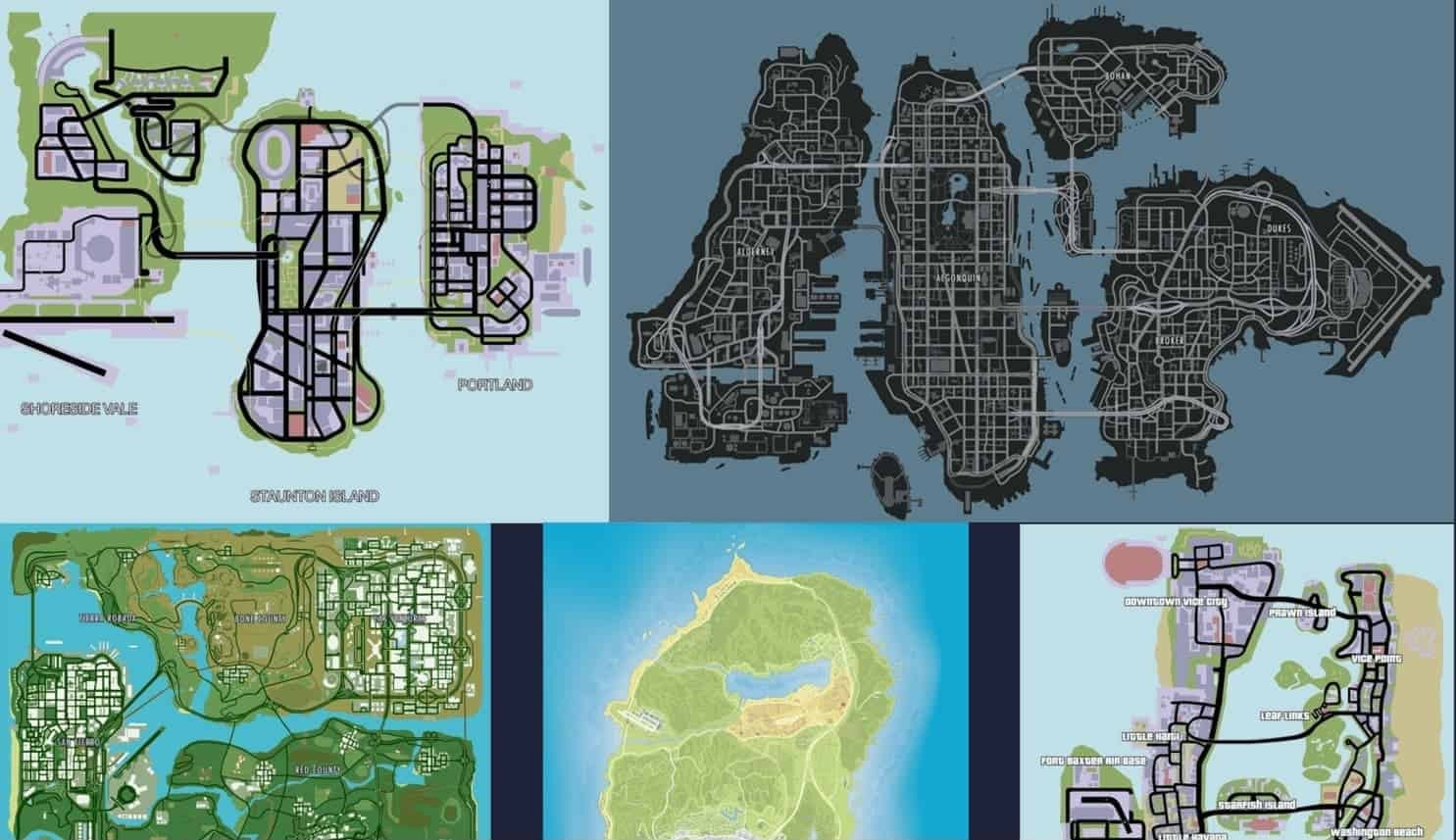The Grand Theft Auto (GTA) series is renowned for its immersive open-world environments, and a crucial element of this immersion is the sheer size and detail of its maps. From the groundbreaking 3D Liberty City in GTA III to the sprawling expanse of Los Santos in GTA V, each iteration has pushed the boundaries of virtual world design. This article provides a comprehensive comparison of GTA maps, examining their sizes and evolution throughout the series.
| Game | Land Area (km2) |
|---|---|
| Grand Theft Auto V | 48.15 |
| Grand Theft Auto: San Andreas | 31.55 |
| Grand Theft Auto IV | 8.06 |
| Grand Theft Auto: Vice City | 5.62 |
| Grand Theft Auto III | 4.38 |
This table showcases the land area of each map, highlighting the significant increase in scale over the years. Grand Theft Auto V clearly dominates in terms of landmass, offering players a vast and diverse landscape to explore.
| Game | Water Area (km2) |
|---|---|
| Grand Theft Auto V | 27.69 |
| Grand Theft Auto IV | 8.08 |
| GTA: San Andreas | 6.67 |
| Grand Theft Auto III | 3.76 |
| Grand Theft Auto: Vice City | 3.5 |
The water area also contributes significantly to the overall size and gameplay experience. Grand Theft Auto V again leads in this category, with a substantial ocean surrounding Los Santos, offering opportunities for underwater exploration and naval activities.
| Game | Total Area (km2) |
|---|---|
| Grand Theft Auto V | 75.84 |
| GTA: San Andreas | 38.2 |
| Grand Theft Auto IV | 16.14 |
| Grand Theft Auto: Vice City | 9.11 |
| Grand Theft Auto III | 8.12 |
When considering the total area, which combines both land and water, the scale of map evolution becomes even more apparent. The progression from Grand Theft Auto III to Grand Theft Auto V demonstrates Rockstar Games’ commitment to creating increasingly expansive and detailed worlds.
 A comparison of GTA game maps showcasing the evolution of map size from GTA 3 to GTA 5, emphasizing the significant increase in scale and detail over the Grand Theft Auto series.
A comparison of GTA game maps showcasing the evolution of map size from GTA 3 to GTA 5, emphasizing the significant increase in scale and detail over the Grand Theft Auto series.
Grand Theft Auto III (2001)
Grand Theft Auto III marked a revolutionary shift for the series, transitioning to a 3D open world. Liberty City, though smaller in size compared to later installments, felt expansive and immersive for its time. Divided into three distinct islands – Portland, Staunton Island, and Shoreside Vale – each borough offered unique environments and criminal activities. This rendition of Liberty City laid the foundation for future open-world games, providing a dense urban playground for players to explore.
Grand Theft Auto: Vice City (2002)
Building upon the success of GTA III, Grand Theft Auto: Vice City transported players to a vibrant, 1980s-inspired metropolis modeled after Miami. Vice City expanded on the map size of its predecessor, featuring two primary islands teeming with neon-lit streets, beaches, and iconic landmarks. The game’s map not only increased in size but also in personality, reflecting the cultural excesses and stylistic flair of the decade.
Grand Theft Auto: San Andreas (2004)
Grand Theft Auto: San Andreas delivered a quantum leap in map design. Introducing the vast state of San Andreas, players could traverse three distinct cities – Los Santos, San Fierro, and Las Venturas – alongside sprawling countryside, deserts, and mountain ranges. The sheer scale and diversity of San Andreas set a new standard for open-world game environments, offering unparalleled freedom and exploration possibilities. This map was not just about urban sprawl; it encompassed a wide variety of landscapes, making it feel like a truly living world.
Grand Theft Auto IV (2008)
Returning to Liberty City, Grand Theft Auto IV presented a more realistic and densely populated urban environment. While smaller than the expansive San Andreas, GTA IV’s Liberty City was meticulously detailed, emphasizing verticality and interconnectedness. Comprising four boroughs and Alderney, this map prioritized depth and realism over sheer size, creating a believable and immersive modern city experience. The focus shifted towards intricate street layouts, realistic building interiors, and a living, breathing city atmosphere.
Grand Theft Auto V (2013)
Grand Theft Auto V redefined open-world scale once again with its rendition of San Andreas, focusing on the sprawling city of Los Santos and its encompassing Blaine County. This map is not only the largest in the GTA series to date but also incredibly detailed and diverse. From the bustling urban center of Los Santos to the majestic Mount Chiliad and the vast Pacific Ocean, GTA V’s map offers an unmatched level of environmental variety and visual fidelity. The density of activities and points of interest further enhances the feeling of a truly massive and engaging world.
Anticipating the Size of Grand Theft Auto VI
The gaming community is eagerly anticipating the map size of the upcoming Grand Theft Auto VI. Rumors and leaks suggest a potentially massive game world, with some reports even claiming it could be significantly larger than GTA V’s already enormous map. While official details remain scarce, the trend of increasing map sizes throughout the GTA series suggests that Grand Theft Auto VI is likely to deliver an unprecedentedly expansive and immersive open-world environment, further pushing the boundaries of virtual world design in gaming.
Grand Theft Auto maps have consistently evolved, each iteration offering players larger and more detailed environments to explore. From the pioneering 3D world of GTA III to the colossal scale of GTA V, the series has continually redefined open-world gaming. As anticipation builds for GTA VI, the question of map size remains a central point of excitement for fans worldwide.
